The Effect of the Human Footprint and Climate Change on Landscape Ecological Risks: A Case Study of the Loess Plateau, China
Abstract
:1. Introduction
2. Materials and Methods
2.1. Study Area
2.2. Data Source
2.3. Methods
2.3.1. Moving Window
2.3.2. Ecological Risk Assessment
2.3.3. Human Footprint Index
- (1)
- Land use and land cover
- (2)
- Nighttime light
- (3)
- Population density
- (4)
- Road
- (5)
- Railway
2.3.4. Modification of Human Footprint Data
- (1)
- Water bodies
- (2)
- Nature Reserves
2.3.5. Climate Change Factors Selection
- (1)
- The annual average temperature statistics of the Loess Plateau sub-counties for the years 2000, 2010, and 2020 year were selected to detect the driving forces of spatial evolution of landscape ecological risk in the Loess Plateau.
- (2)
- Fourcade et al. believe that the response of communities and other ecosystems to climate change is evidently lagging, forming a “climate debt” [43]. Anderegg et al. pointed out that within 1–4 years after encountering extreme weather events, such as drought, the ecosystems, especially forests ecosystem, will be severely affected [44]. Therefore, the average temperature data of the study period and the previous two years were used to calculate the multi-year average temperature (i.e., average lagged temperature) to adapt to the impact of the climate debt.
2.3.6. Geographical Detector Model
- (1)
- Factor Detector
- (2)
- Interaction Detector
- (3)
- Ecological Detector
- (4)
- Risk Detector
3. Results
3.1. Moving Window
3.2. LERI of Loess Plateau
3.3. Human Footprint of Loess Plateau
3.4. Climate Factor of Loess Plateau
3.5. Driving Factor Explore Result Using the Geographical Detector Model
3.5.1. Geodetector Runs for Each Individual Factor Result
- (1)
- Factor Detector Result
- (2)
- Interaction Detector Result
- (3)
- Ecological Detector and Risk Detector Result
3.5.2. Geodetector Runs for the Integrated Human Footprint Index Results
4. Discussion
5. Conclusions
Author Contributions
Funding
Institutional Review Board Statement
Informed Consent Statement
Data Availability Statement
Conflicts of Interest
References
- Peng, J.; Wang, Y.; Wu, J.; Zhang, Y. Evaluation for regional ecosystem health: Methodology and research progress. Acta Ecol. Sin. 2007, 27, 4877–4885. [Google Scholar] [CrossRef]
- Wu, J. Landscape sustainability science: Ecosystem services and human well-being in changing landscapes. Landsc. Ecol. 2013, 28, 999–1023. [Google Scholar] [CrossRef]
- Summer, J.K.; Smith, L.M.; Case, J.L.; Linthurst, R.A. A Review of the Elements of Human Well-Being with an Emphasis on the Contribution of Ecosystem Services. Ambio 2012, 41, 327–340. [Google Scholar] [CrossRef] [PubMed] [Green Version]
- Assesment, M.E. Ecosystems and human well-being: Synthesis. Phys. Teach. 2005, 34, 534. [Google Scholar]
- Wei, J.; Xiao, D.; Xie, F. Evaluation and Regulation Principles for the Effects of Human Activities on Ecology and Environment. Prog. Geogr. 2006, 25, 36–45. [Google Scholar]
- Zheng, H.; Ouyang, Z.; Zhao, T.; Li, Z.; Xu, W. The impact of human activities on ecosystem services. J. Nat. Resour. 2003, 18, 118–126. [Google Scholar]
- Chapman, D.S.; Gunn, I.D.M.; Pringle, H.E.K.; Siriwardena, G.M.; Taylor, P.; Thackeray, S.J.; Willby, N.J.; Carvalho, L. Invasion of freshwater ecosystems is promoted by network connectivity to hotspots of human activity. Global Ecol. Biogeogr. 2020, 29, 645–655. [Google Scholar] [CrossRef] [Green Version]
- Vitousek, P.M.; Mooney, H.A.; Lubchenco, J.; Melillo, J.M. Human Domination of Earth’s Ecosystems. Science 1997, 277, 494–499. [Google Scholar] [CrossRef] [Green Version]
- Yu, T.; Bao, A.; Xu, W.; Guo, H.; Jiang, L.; Zheng, G.; Yuan, Y.; Nzabarinda, V. Exploring Variability in Landscape Ecological Risk and Quantifying Its Driving Factors in the Amu Darya Delta. Int. J. Environ. Res. Public Health 2019, 17, 79. [Google Scholar] [CrossRef] [Green Version]
- Peng, J.; Dang, W.; Liu, Y.; Zong, M.; Hu, X. Review on landscape ecological risk assessment. Acta Geogr. Sin. 2015, 70, 664–677. [Google Scholar]
- Liu, H.; Liu, L.; Ding, S. The impact of human activities on ecosystem services flow. Acta Ecol. Sin. 2017, 37, 3232–3242. [Google Scholar]
- Cao, Q.; Zhang, X.; Ma, H.; Wu, J. Review of landscape ecological risk and an assessment framework based on ecological services: ESRISK. Acta Geogr. Sin. 2018, 73, 843–855. [Google Scholar]
- Peng, J.; Zong, M.; Hu, Y.; Liu, Y.; Wu, J. Assessing Landscape Ecological Risk in a Mining City: A Case Study in Liaoyuan City, China. Sustainability 2015, 7, 8312–8334. [Google Scholar] [CrossRef] [Green Version]
- Xie, H.; Wen, J.; Chen, Q.; Wu, Q. Evaluating the landscape ecological risk based on GIS: A case-study in the Poyang Lake region of China. Land Degrad. Dev. 2021, 32, 2762–2774. [Google Scholar] [CrossRef]
- Fu, W.; Lv, Y.; Fu, B.; Hu, W. Landscape Ecological Risk Assessment Under the Influence of Typical Human Activities in Loess plateau, Northern Shaanxi. J. Ecol. Rural Environ. 2019, 35, 290–299. [Google Scholar]
- Wang, F.; Ye, C.; Hua, J.; Li, X. Coupling relationship between urban spatial expansion and landscape ecological risk in Nanchang City. Acta Ecol. Sin. 2019, 39, 1248–1262. [Google Scholar]
- Liao, J.; Jia, Y.; Tang, L.; Huang, Q.; Wang, Y.; Huang, N.; Hua, L. Assessment of urbanization-induced ecological risks in an area with significant ecosystem services based on land use/cover change scenarios. Int. Sust. Dev. World 2017, 25, 448–457. [Google Scholar] [CrossRef]
- Lou, N.; Wang, Z.; He, S. Assessment on Ecological Risk of Aha Lake National Wetland Park Based on Landscape Pattern. Res. Soil Water Conserv. 2020, 27, 233–239. [Google Scholar]
- Zhang, W.; Chang, W.J.; Zhu, Z.C.; Hui, Z. Landscape ecological risk assessment of Chinese coastal cities based on land use change. Appl. Geogr. 2020, 117, 102174. [Google Scholar] [CrossRef]
- Zhao, G.; Liu, J.; Kuang, W.; Ouyang, Z.; Xie, Z. Disturbance impacts of land use change on biodiversity conservation priority areas across China: 1990–2010. Acta Geogr. Sin. 2015, 25, 515–529. [Google Scholar] [CrossRef] [Green Version]
- Liu, J.; Wang, M.; Yang, L. Assessing Landscape Ecological Risk Induced by Land-Use/Cover Change in a County in China: A GIS- and Landscape-Metric-Based Approach. Sustainability 2020, 12, 9037. [Google Scholar] [CrossRef]
- Xu, W.; Wang, J.; Zhang, M.; Li, S. Construction of landscape ecological network based on landscape ecological risk assessment in a large-scale opencast coal mine area. J. Cleaner Prod. 2020, 286, 125523. [Google Scholar] [CrossRef]
- Mo, W.; Wang, Y.; Zhang, Y.; Zhuang, D. Impacts of road network expansion on landscape ecological risk in a megacity, China: A case study of Beijing. Sci. Total Environ. 2017, 574, 1000–1011. [Google Scholar] [CrossRef] [PubMed] [Green Version]
- Jing, Y.; Zhang, S.; Li, Y. Ecological analysis of rural-urban ecotone based on landscape structure. Chin. J. Ecol. 2008, 27, 229–234. [Google Scholar]
- Yan, J.; Li, G.; Qi, G.; Qiao, H.; Nie, Z.; Huang, C.; Kang, Y.; Sun, D.; Zhang, M.; Kang, X.; et al. Landscape ecological risk assessment of farming-pastoral ecotone in China based on terrain gradients. Hum. Ecol. Risk Assess. 2021, 27, 2124–2141. [Google Scholar] [CrossRef]
- Kienast, F.; Wildi, O.; Brzeziecki, B. Potential impacts of climate change on species richness in mountain forests—An ecological risk assessment. Biol. Conserv. 1998, 83, 291–305. [Google Scholar] [CrossRef]
- Landis, W.G.; Durda, J.L.; Brooks, M.L.; Chapman, P.M.; Menzie, C.A.; Stahl, R.G.; Stauber, J.L. Ecological risk assessment in the context of global climate change. Environ. Toxicol. Chem. 2012, 32, 79–92. [Google Scholar] [CrossRef]
- Shi, H.; Chen, J. Characteristics of climate change and its relationship with land use/cover change in Yunnan Province, China. Int. J. Climatol. 2018, 38, 2520–2537. [Google Scholar] [CrossRef]
- Wu, L.; Hou, X.; Di, X. Assessment of regional ecological risk in coastal zone of Shandong Province. Chin. J. Ecol. 2014, 33, 214–220. [Google Scholar]
- Shi, H.; Yang, Z.; Han, F.; Shi, T.; Li, D. Assessing Landscape ECOLOGICAL Risk for a World Natural Heritage Site: A Case Study of Bayanbulak in China. Pol. J. Environ. Stud. 2015, 24, 269–283. [Google Scholar] [CrossRef]
- Zhou, S.; Chang, J.; Hu, T.; Luo, P.; Zhou, H. Spatiotemporal Variations of Land Use and Landscape Ecological Risk in a Resource-Based City, from Rapid Development to Recession. Pol. J. Environ. Stud. 2020, 29, 475–490. [Google Scholar] [CrossRef]
- Liu, M.; Wang, Y.; Pei, H. Landscape Ecological Risk Assessment in Bashang Area of Hebei Province Based on Land Use Change. Bull. Soil Water Conserv. 2020, 40, 303–311. [Google Scholar]
- Liu, X.; Li, X.; Jiang, D. Landscape pattern identification and ecological risk assessment using land-use change in the Yellow River Basin. Trans. Chin. Soc. Agric. Eng. 2021, 37, 265–274. [Google Scholar]
- Wang, Z. Boundary data of Loess Plateau region. In Global Change Research Data Publishing & Repository; Institute of Geographic Sciences and Natural Resources Research: Beijing, China, 2015. [Google Scholar] [CrossRef]
- Shao, D.; Wu, D. Analysis on the Effect of Landscape Fragmentation on Ecosystem Service Value: A Case Study of Suzhou. Resour. Environ. Yangtze Basin 2020, 29, 2346–2449. [Google Scholar]
- Chen, L.; Fu, B. Anlalysis of Impact of Human Activity on Landscape Structure in Yellow River Delta—A Case Study of Dongying Region. Acta Ecol. Sin. 1996, 16, 337–344. [Google Scholar]
- Lifton, N.A.; Chase, C.G. Tectonic, climatic and lithologic influences on landscape fractal dimension and hypsometry: Implications for landscape evolution in the San Gabriel Mountains, California. Geomorphology 1992, 5, 77–114. [Google Scholar] [CrossRef]
- Duan, Q.; Luo, L. A dataset of human footprint over the Qinghai-Tibet Plateau during 1990–2015. China Sci. Data 2020, 5, 303–312. [Google Scholar] [CrossRef]
- Tan, M.; Li, X.; Li, S.; Xin, L.; Wang, X.; Li, Q.; Li, W.; Li, Y.; Xiang, W. Modeling population density based on nighttime light images and land use data in China. Appl. Geogr. 2018, 90, 239–247. [Google Scholar] [CrossRef]
- Li, X.; Xu, H.; Chen, X.; Li, C. Potential of NPP-VIIRS Nighttime Light Imagery for Modeling the Regional Economy of China. Remote Sens. 2013, 5, 3057–3081. [Google Scholar] [CrossRef] [Green Version]
- Shi, K.; Yu, B.; Huang, Y.; Hu, Y.; Yin, B.; Chen, Z.; Chen, L.; Wu, J. Evaluating the Ability of NPP-VIIRS Nighttime Light Data to Estimate the Gross Domestic Product and the Electric Power Consumption of China at Multiple Scales: A Comparison with DMSP-OLS Data. Remote Sens. 2014, 6, 1705–1724. [Google Scholar] [CrossRef] [Green Version]
- Cao, Z.; Wu, Z.; Kuang, Y.; Huang, N. Correction of DMSP/OLS Night-time Light Images and Its Application in China. J. Geo-Inf. Sci. 2015, 17, 1092–1102. [Google Scholar]
- Fourcade, Y.; WallisDeVries, M.F.; Kuussaari, M.; Swaay, C.A.M.; Heliölä, J.; Öckinger, E. Habitat amount and distribution modify community dynamics under climate change. Ecol. Lett. 2021, 24, 950–957. [Google Scholar] [CrossRef] [PubMed]
- Anderegg, W.R.L.; Schwalm, C.; Biondi, F.; Camarero, J.J.; Koch, G.; Litvak, M.; Ogle, K.; Shaw, J.D.; Shevliakova, E.; Williams, A.P.; et al. Pervasive drought legacies in forest ecosystems and their implications for carbon cycle models. Science 2015, 349, 520–532. [Google Scholar] [CrossRef] [PubMed] [Green Version]
- Wang, J.; Xu, C. Geodetector: Principle and prospective. Acta Geogr. Sin. 2017, 72, 116–134. [Google Scholar]
- Ren, J.; Peng, S.; Cao, Y.; Huo, X.; Chen, Y. Spatiotemporal Distribution Characteristics of Climate Change in the Loess Plateau from 1901 to 2014. J. Nat. Resour. 2018, 33, 621–633. [Google Scholar]
- Zhang, R. Climate Observing System and Related Crucial Issues. J. Appl. Meteor. Sci. 2006, 17, 705–710. [Google Scholar]
- Henson, S.A.; Beaulieu, C.; Lampitt, R. Observing climate change trends in ocean biogeochemistry: When and where. Glob. Chang. Biol. 2016, 22, 1561–1571. [Google Scholar] [CrossRef] [PubMed] [Green Version]
- Wang, X.; Zhang, Q.; Liu, X.; Wen, W. Concept and Standard of Ecological Compensation, and Roles of Human Activities to Ecological System. China Popu. Res. Envi. 2010, 20, 41–50. [Google Scholar]
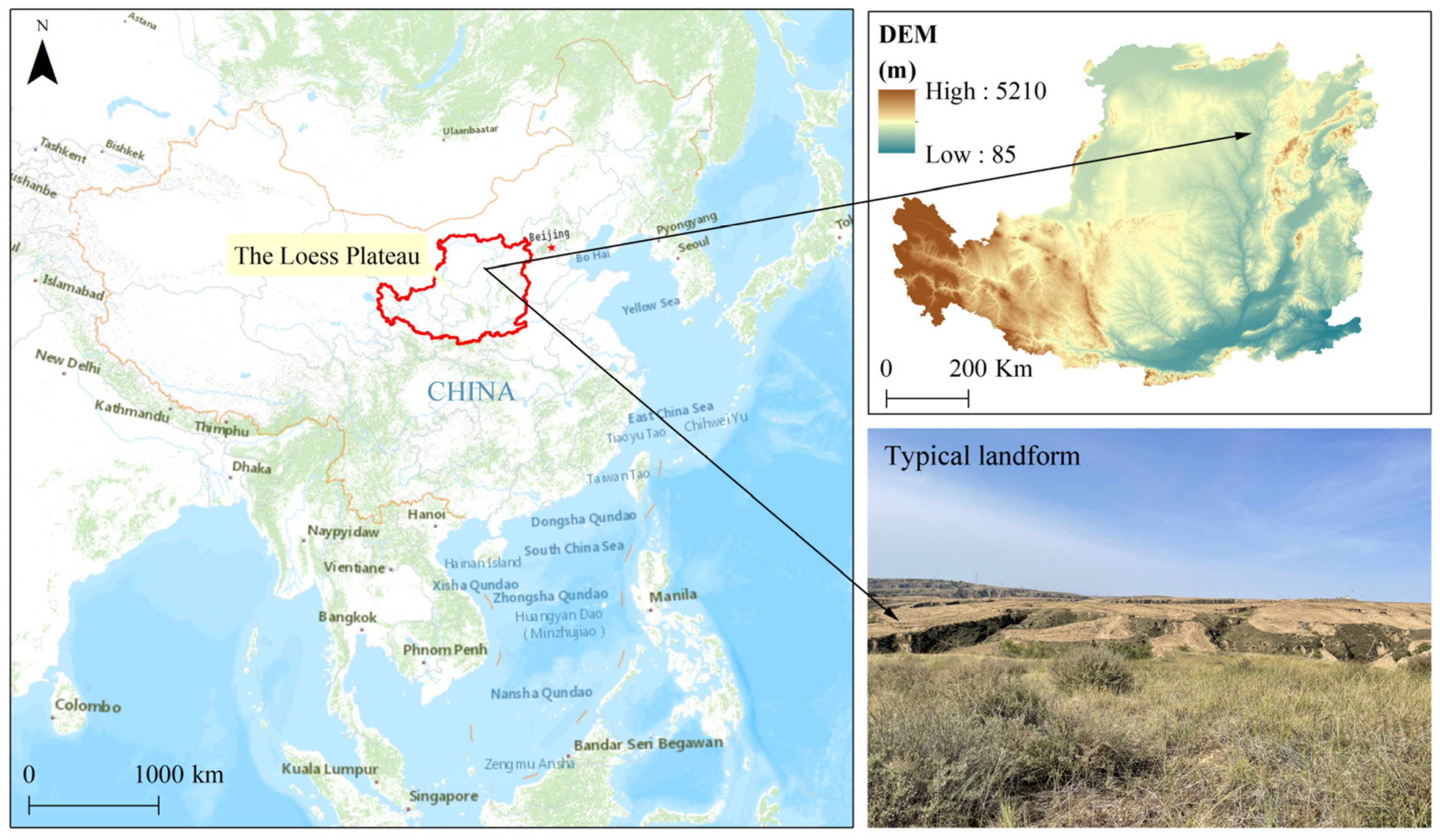
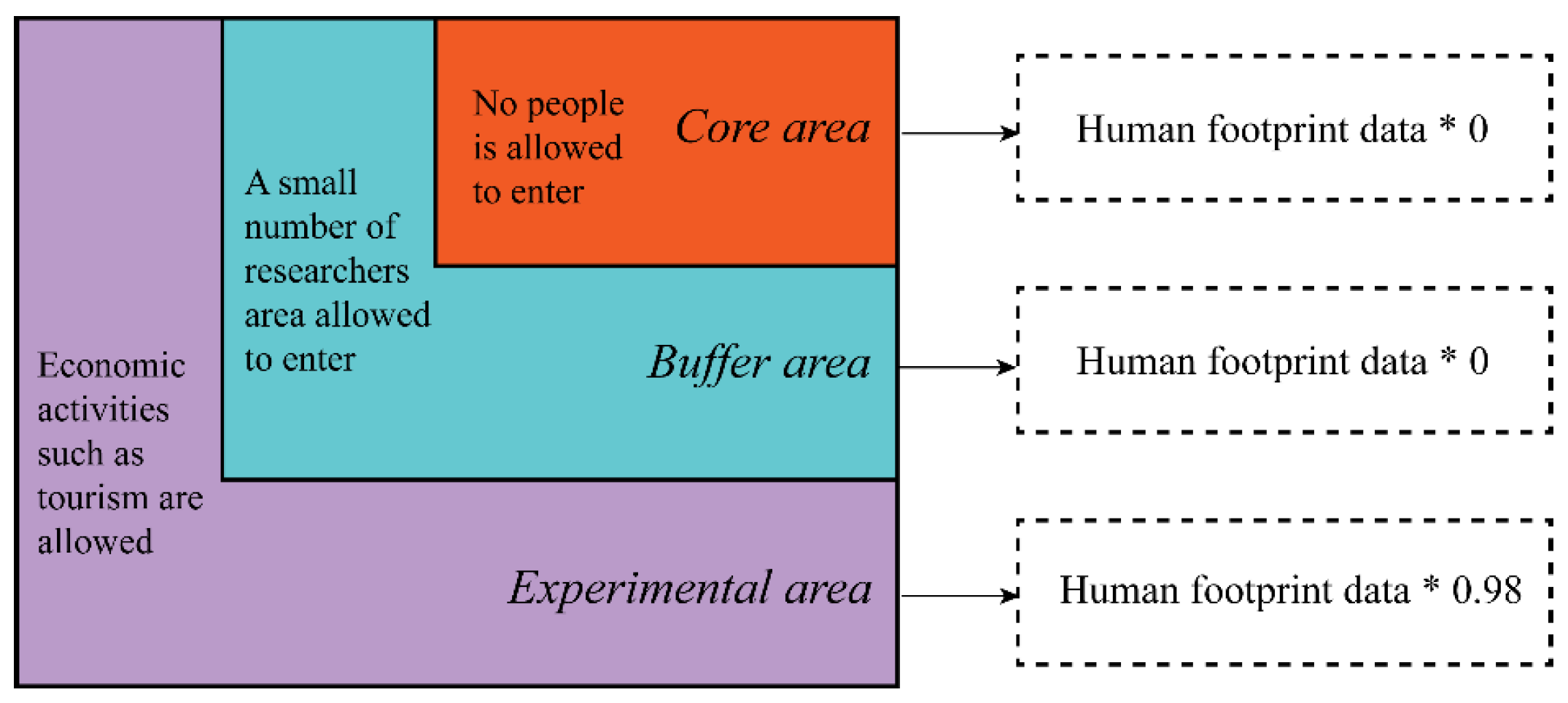
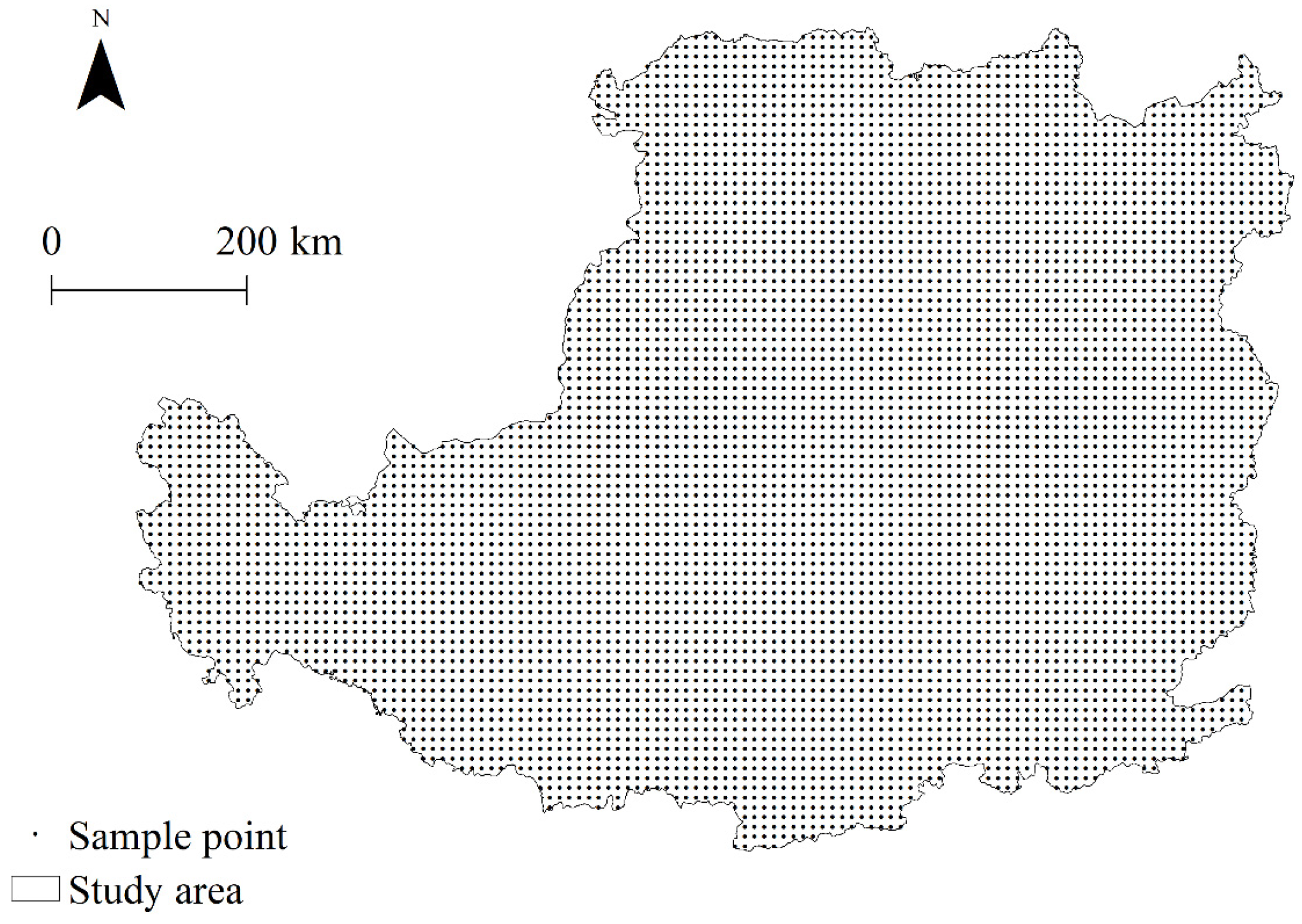
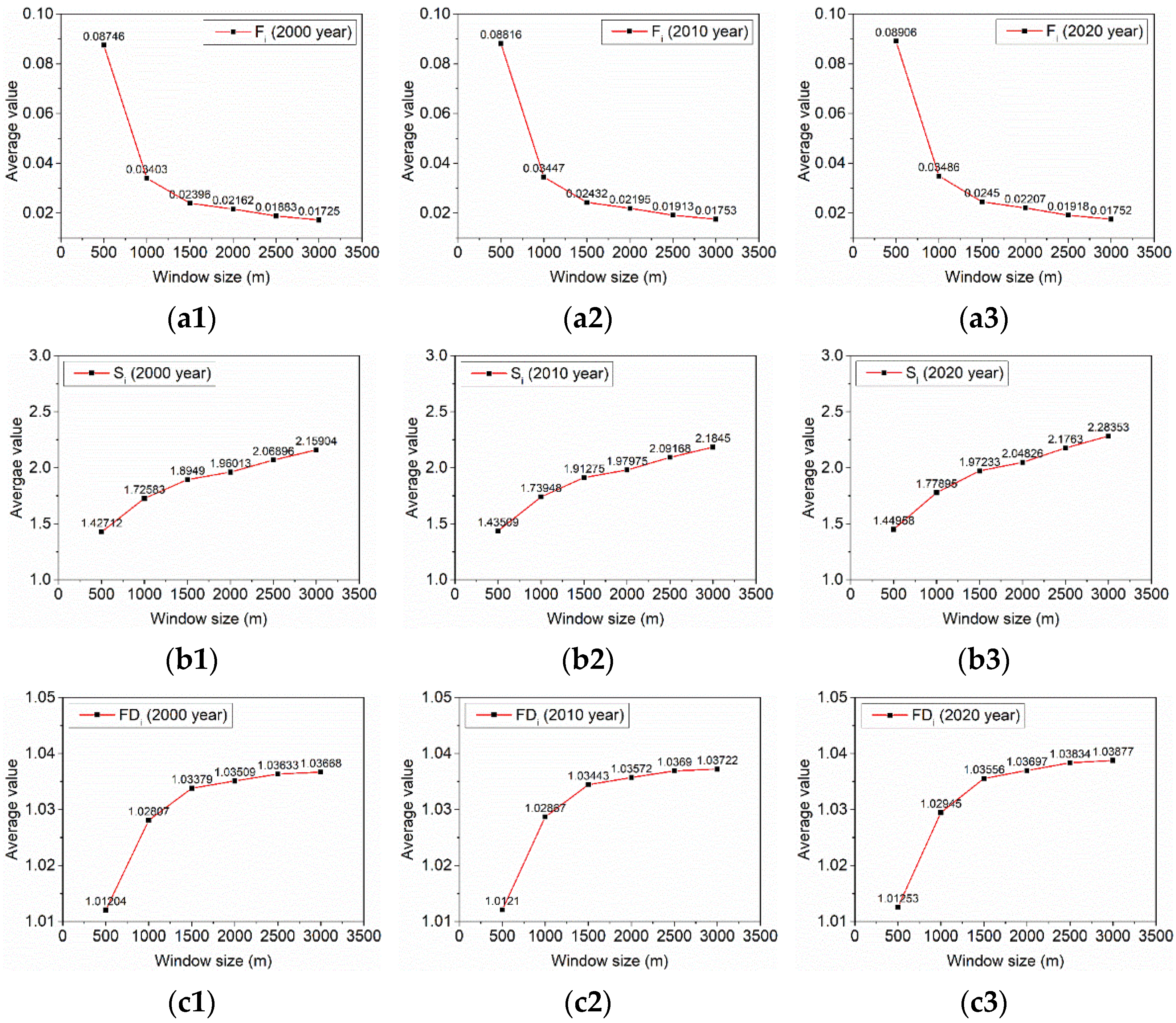


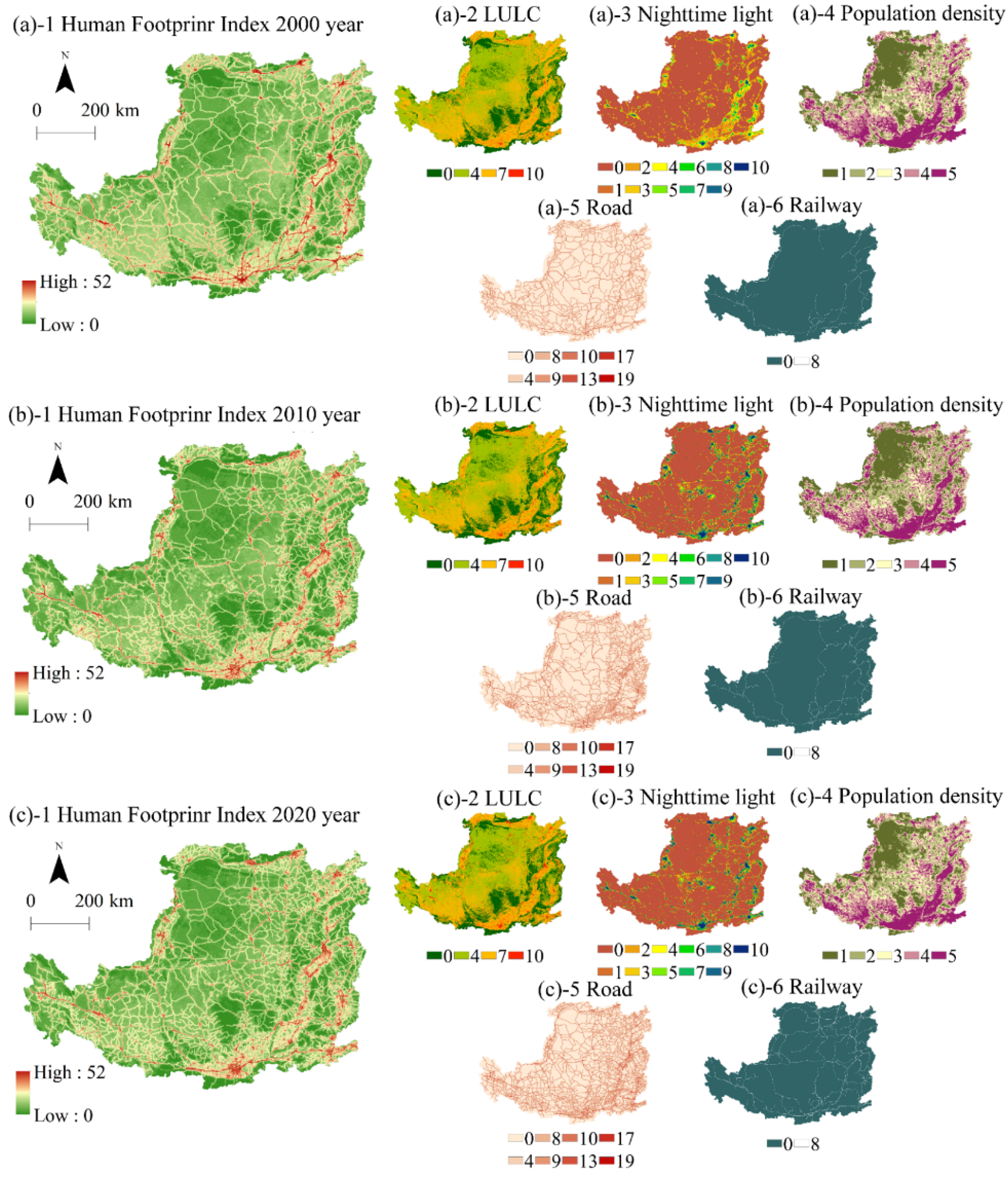
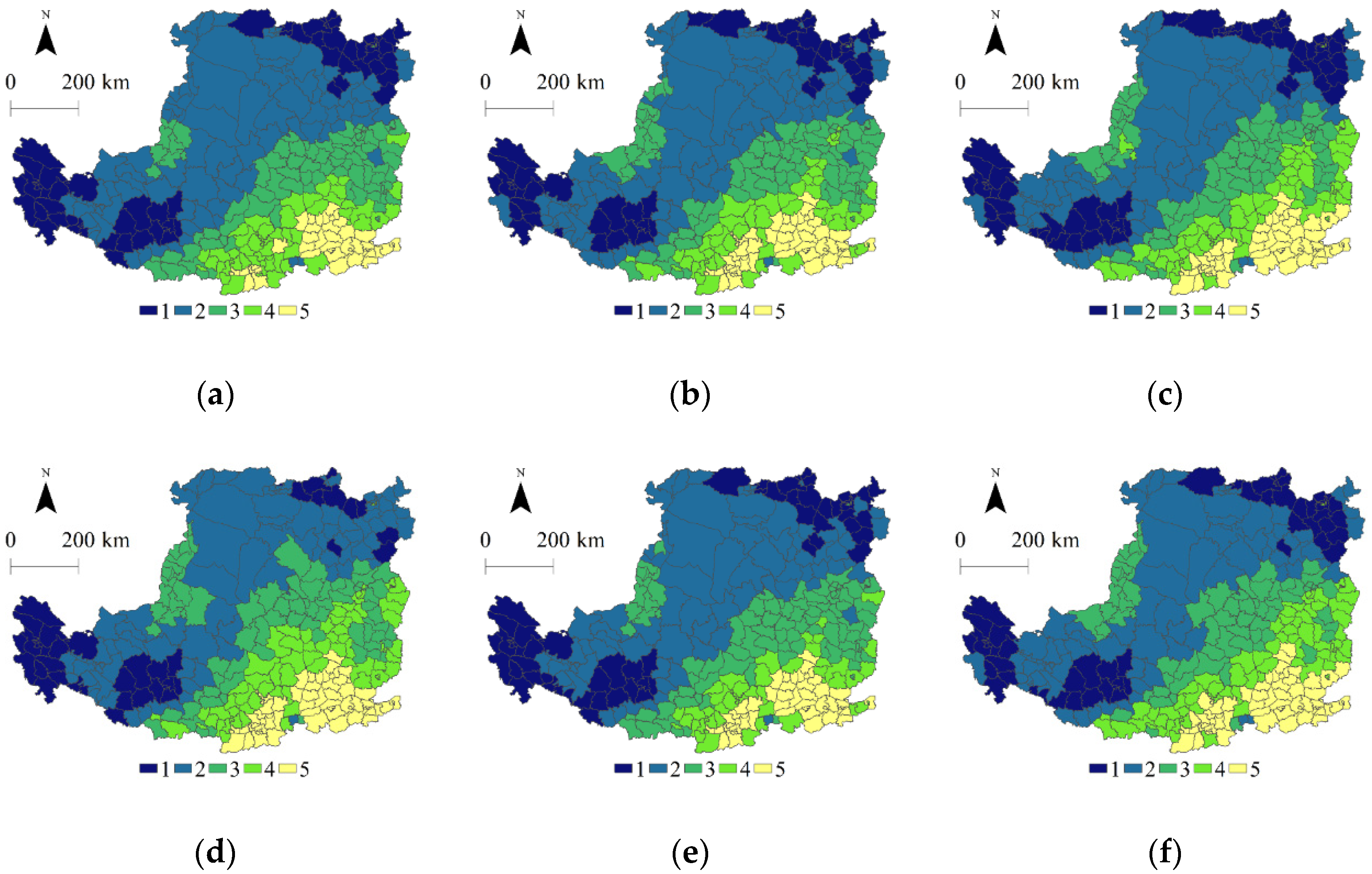
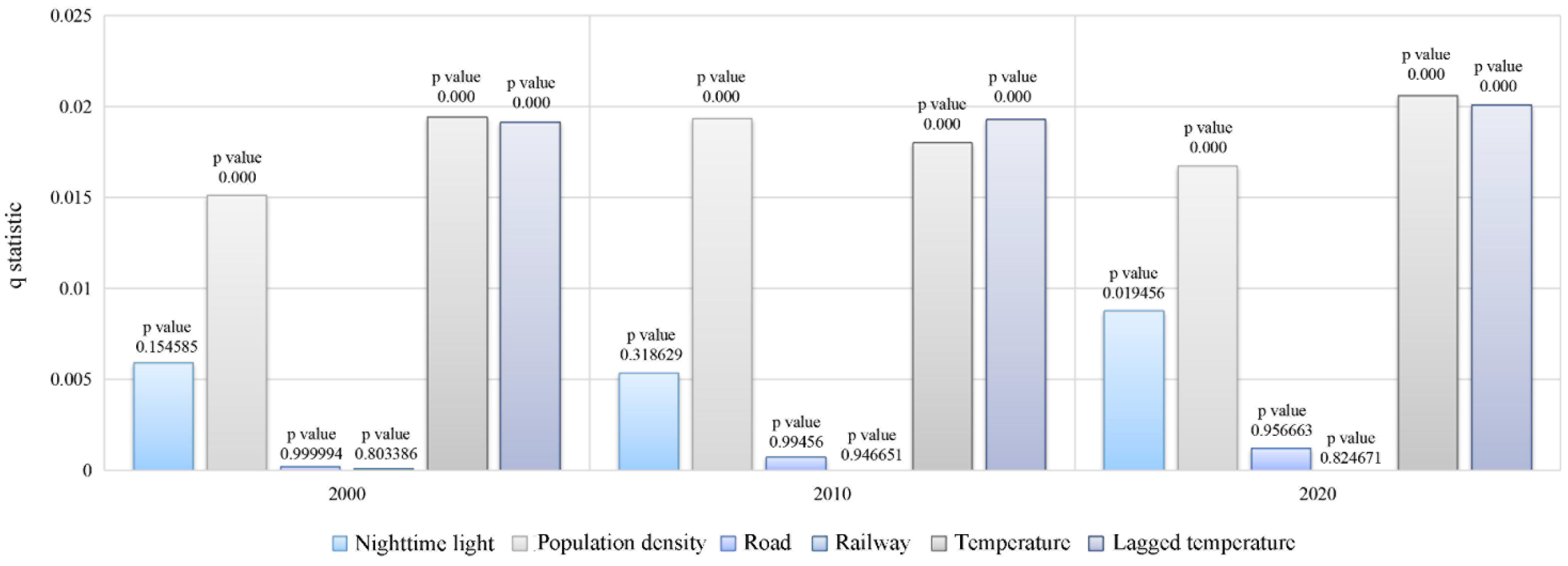
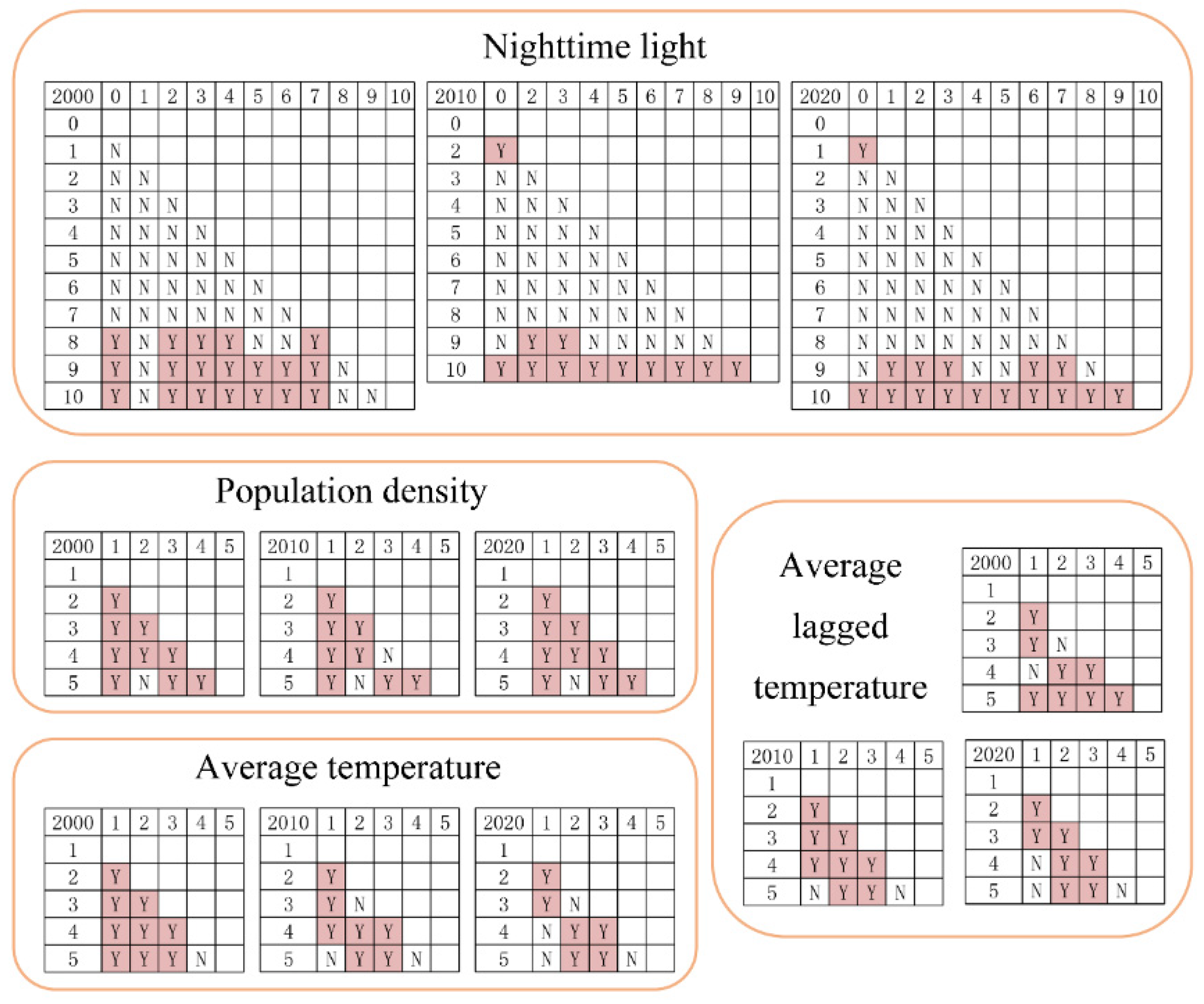

| Factors | Selection Basis | The Range of Values after Assignment |
|---|---|---|
| LUCC | Reflects the degree of human influence on different land types. | 0, 4, 7, 10 |
| Nighttime light | Reflects the spatial distribution of the population and towns, as well as economic activities, electricity consumption and carbon emissions. | 0–10 |
| Population density | Reflects the number of people per square kilometer. | 0–10 |
| Main road | Reflecting the human arrival area, evaluates the scope of impact on the surroundings. | 4, 8, 10 |
| Railway | Reflecting the human arrival area, evaluates the scope of impact on the surroundings. | 8 |
| Judgments Based | Interaction |
|---|---|
| q(X1 ∩ X2) < Min(q(X1),q(X2)) | Weakened, nonlinear |
| Min(q(X1),q(X2)) < q(X1 ∩ X2) < Max(q(X1),q(X2)) | Weakened, nonlinear, single factor |
| q(X1 ∩ X2) > Max(q(X1),q(X2)) | Enhanced, double factor |
| q(X1 ∩ X2) = q(X1) + q(X2)) | Independence |
| q(X1 ∩ X2) > q(X1) + q(X2)) | Enhanced, nonlinear |
| Area (km2) | Lowest | Lower | Medium | Higher | Highest |
|---|---|---|---|---|---|
| 2000 year | 85,371.6501 | 167,656.8708 | 135,642.7890 | 119,017.3698 | 113,566.1553 |
| 2010 year | 93,878.2602 | 159,297.2541 | 133,951.2966 | 119,551.9689 | 114,575.6772 |
| 2020 year | 106,367.3118 | 140,546.9430 | 132,820.7013 | 120,801.3426 | 120,718.5363 |
Publisher’s Note: MDPI stays neutral with regard to jurisdictional claims in published maps and institutional affiliations. |
© 2022 by the authors. Licensee MDPI, Basel, Switzerland. This article is an open access article distributed under the terms and conditions of the Creative Commons Attribution (CC BY) license (https://creativecommons.org/licenses/by/4.0/).
Share and Cite
Qu, Z.; Zhao, Y.; Luo, M.; Han, L.; Yang, S.; Zhang, L. The Effect of the Human Footprint and Climate Change on Landscape Ecological Risks: A Case Study of the Loess Plateau, China. Land 2022, 11, 217. https://doi.org/10.3390/land11020217
Qu Z, Zhao Y, Luo M, Han L, Yang S, Zhang L. The Effect of the Human Footprint and Climate Change on Landscape Ecological Risks: A Case Study of the Loess Plateau, China. Land. 2022; 11(2):217. https://doi.org/10.3390/land11020217
Chicago/Turabian StyleQu, Zhi, Yonghua Zhao, Manya Luo, Lei Han, Shuyuan Yang, and Lei Zhang. 2022. "The Effect of the Human Footprint and Climate Change on Landscape Ecological Risks: A Case Study of the Loess Plateau, China" Land 11, no. 2: 217. https://doi.org/10.3390/land11020217
APA StyleQu, Z., Zhao, Y., Luo, M., Han, L., Yang, S., & Zhang, L. (2022). The Effect of the Human Footprint and Climate Change on Landscape Ecological Risks: A Case Study of the Loess Plateau, China. Land, 11(2), 217. https://doi.org/10.3390/land11020217







